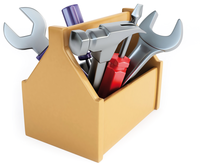Toolbox
Whether it be themes and templates, JavaScript or regex, responsive design or typography, resourceful web designers make work easier for themselves with the many freely available tools on the web.

Karel Miragaya, 123RF
Whether it be themes and templates, JavaScript or regex, responsive design or typography, resourceful web designers make work easier for themselves with the many freely available tools on the web.
As a budding web developer, you don't have to search very long to find the right tool to make your web presence known. Many useful tools for designing and testing websites are freely available on the web. I'll look at six of them here.
When working with a popular content management systems (CMSs), such as WordPress, Drupal, or Serendipity, you'll notice no shortage of appealing templates for web design. Each project page usually has a collection developed by the community. In the WordPress Themes directory [1], for example, you can choose from more than 2,500 WordPress templates. Even if you lack in-depth knowledge of web development, you can build an attractive website, although problems may still get in the way. Often, the biggest hurdle is correctly referencing stylesheet elements of the theme. For example, should you write bsp {…} , .bsp {…} , #bsp {…} , or .bsp p {…} in style.css , and what do each refer to?
If you're reluctant to refer to Selfhtml.org to read about CSS selectors, then the CSS Diner [2] can give you some helpful hints about cascading style sheets. The little game has you finding the right selector for each of the 26 levels. Enter your answer in the CSS Editor on the left. The HTML Viewer to the right has the HTML code for the items on the table you need to reference in your answer (Figure 1).
[...]